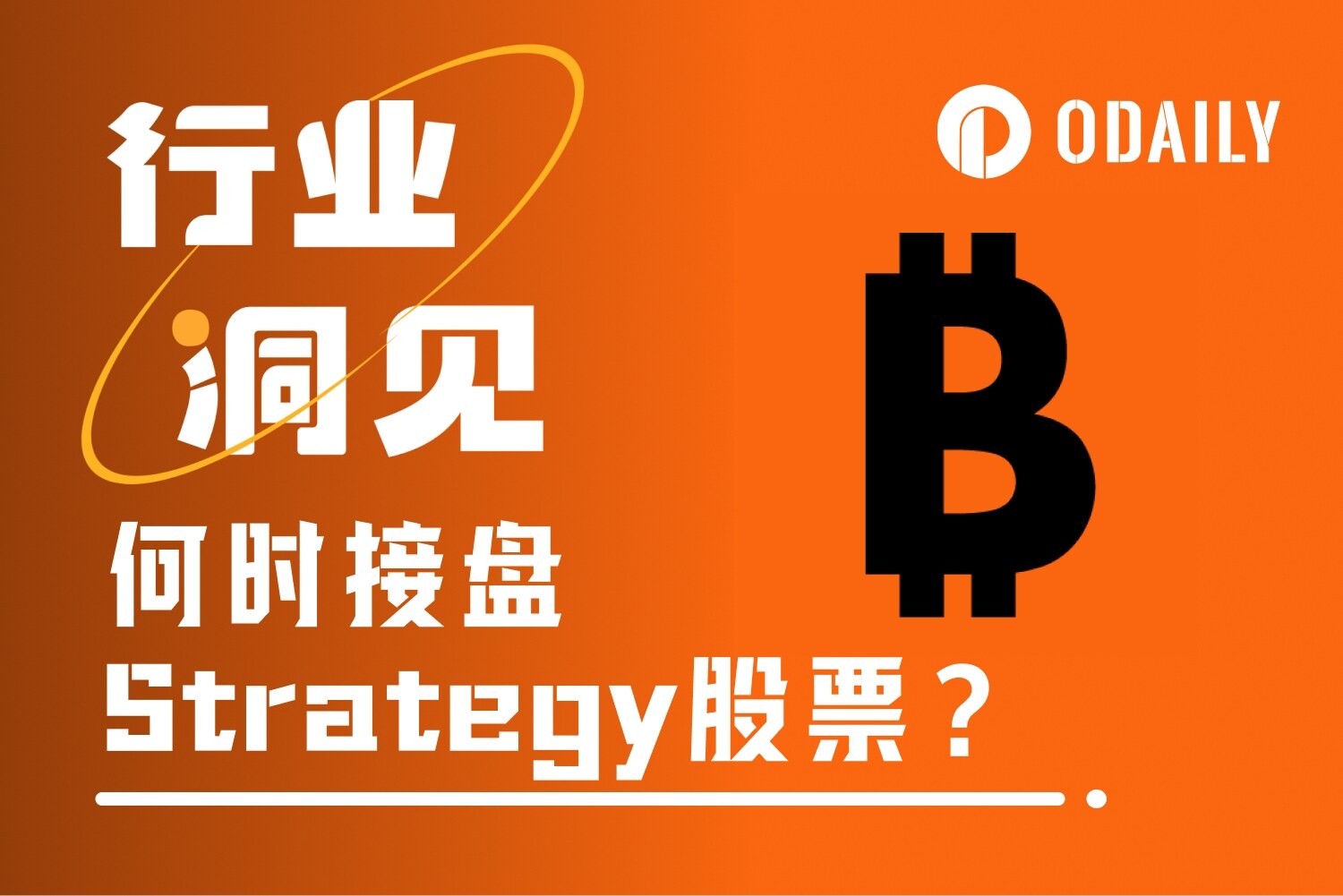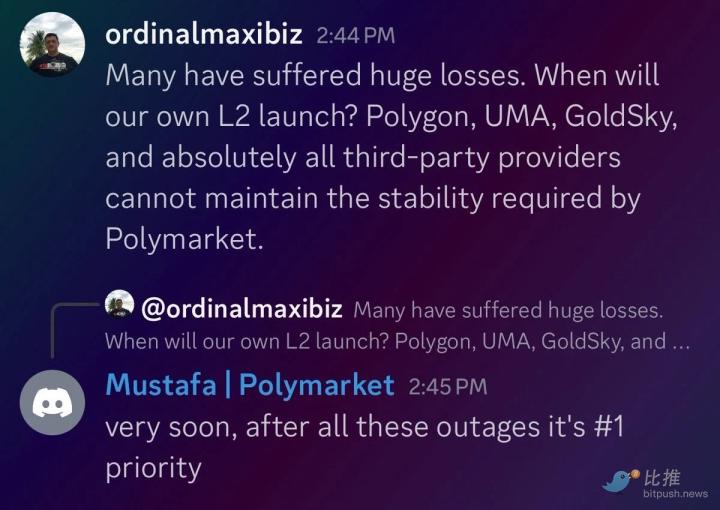Preface
Solana has been around for five years, and Jito (the leader in MEV infrastructure on Solana) has been around for less than three years, but its market share has grown rapidly from the initial 15% to 95% today. It can be said that most of the Meme buying and selling transactions on Solana have to go through it! There is no exaggeration in the whole process, please sit down and collect it, and let Shisijun go deep into the underlying principles and gradually reveal them to you:
- What is Jito-solana? Why can he dominate the market in 2 years?
- The differences in the core mechanisms of Solana vs Ethereum.
- Why do your transactions always get squeezed?
- How will Solana’s MEV landscape develop in the future?
1. What is Jito-solana?
Of course, it is not just Jito-solana (the leader with 95% market share) that is building mev infrastructure on Solana. There are also other manufacturers with different entry points, such as Paladin, Deeznode, BlockRazor, BloxRoute, Galaxy, Nozomi, etc. This article will start with the development history and technical principles of the core leaders, and will comment on the advantages, disadvantages and entry points of these companies in the future.
1. Jito’s development timeline First, let’s use the timeline to look at the magic of its market share development speed. Please pay attention to the pledge rate and related partners.
- Established at the end of 21;
- The Solana mainnet was launched in June 2022, and in September of the same year, there were 200 validators, covering 15% of the staked amount;
- From 2022 to 2023, with financing, iteration and cooperation with Solana foundation, Jito client was included in the official recommendation;
- In the 23rd year of TGE, staking Jito will earn MEV bonus, forming a staking and re-staking model;
- In Q1 2024, due to strong community opposition, the channel for transmitting transactions from jito-solana to jito-blockengine was closed;
- In Q2 of 24, there were more than 500 cooperating validators, covering 70% of Solana’s MEV, and 3 billion transactions were processed in 24 years;
- In Q1 of 25, the pledge coverage rate has reached 94.71%. Today, the importance of cross-chain bridges remains self-evident.
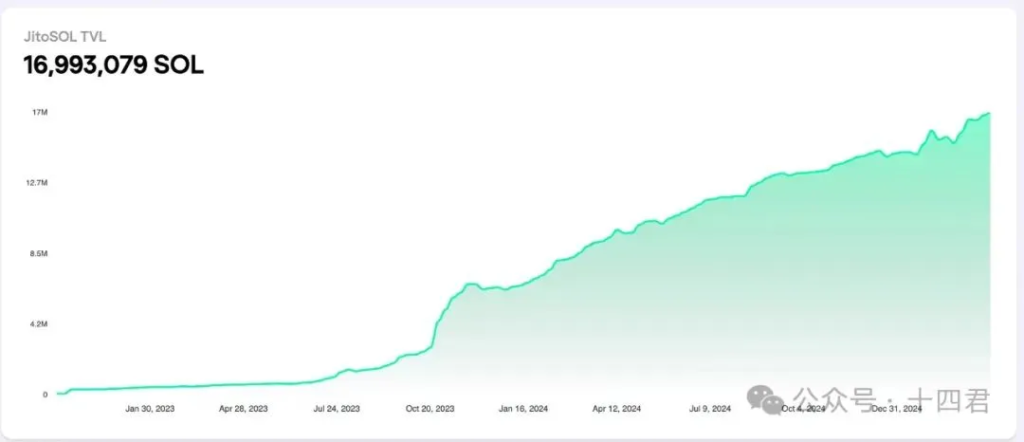
【Image source: https://www.jito.net work/zh/stats/】
Therefore, it can be said that Jito is the leader of infrastructure in the MEV ecosystem on Solana today, and he has been developing for the past three years.
A solid base of support for Solana validators has been established, so that the vast majority of transactions must go through the Jito system.
It was his system diversion that caused Solana's crashes to drop significantly, it was him who allowed the clamps to have high-profit returns, and it was also him who allowed Solana's validators to increase their MEV income by an additional 30%, and steadily. It was him who changed from the original dragon slayer into a dragon, and jumped back and forth between the warrior and the dragon, sometimes ferocious and sometimes kind. In the mainstream meme narrative of today's market, he has become a double-edged swordsman who can play both sides.
2. What kind of system does Jito build?
It actually consists of three core services: block-engine, jito-solana, and jito-relayer. The relationship between them is as follows:
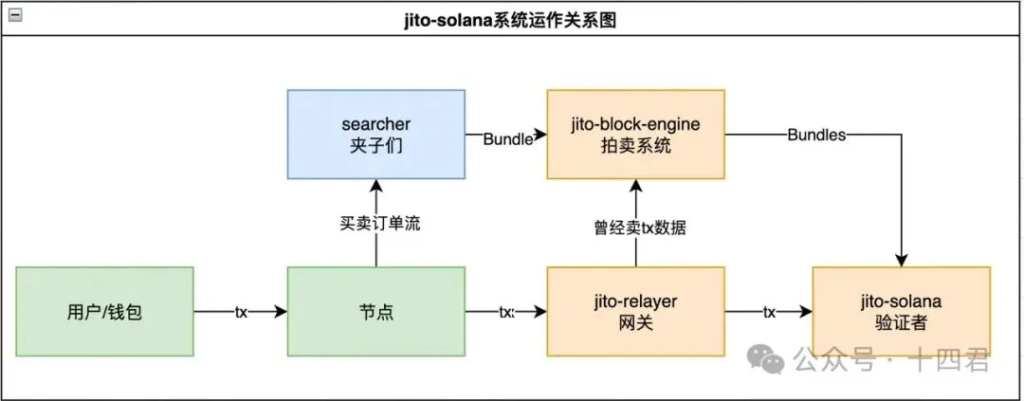
The first is block-engine, which is an auction system.
A typical scenario is to allow the clampers to submit a fixed order of no more than 5 transactions in the form of a Bundle package consisting of multiple transactions for auction. An additional transaction called Tips can be sent to the validators as an additional tip, so that the validators are willing to package the Bundle package first.
Other scenarios include dex platforms like OKX, GMN, and BN Wallet. In order to prevent users from being squeezed, tips can be added to users' transactions individually, taking the auction route to reach the end point of the transaction chain faster.
The second is jito-solana, which is a client that replaces the validator to verify transactions and produce blocks.
Its core function is to allow the validator to receive the Bundle package sent by the block-engine, so as to give priority to the transaction and finally complete the construction of the transaction sequence. At its peak, the number of bundles processed every day could reach 25 million (recently 10 million), and almost every transaction was profitable.
The tips fees collected here are ultimately paid to a unified account, which is then divided between 95–97% for the validator and 3–5% for Jito itself.
Among them, the most controversial is jito-relayer, which can be understood as the gateway of the validator and is used to receive transactions.
Initially, when the relayer receives the transaction, it will delay 200ms and then give it to jito-solana, while the synchronous one will give the transaction to block-engine without delay. Obviously, this is selling order information. Therefore, the initial rise of Jito was due to the interest rate differential that harmed users.
It should be noted that in March 24, this rule was officially announced to no longer transmit data, but to this day, the forwarding switch and 200ms delay setting project can still be found in jito-relayer.
So, do validators sell user information now? All of this is unknown due to the closed source nature of blockengine.
3. How much money does the Jito system make?
Obviously, the spread between transactions with and without a clamp will be introduced along with the tips mechanism and will eventually be given to the validator, thus causing the current situation of a crazy increase in his market share. Who would turn down 30% more profit?
Therefore, the total number of bundles launched in the past year has reached 4.3 billion, and the total tips fees generated have reached 5.51 million SOLs. Based on the market price of 140, the jito infrastructure has generated an additional profit of US$7.7 billion.

[Image source: https://explorer.jito.wtf/]
However, not all of this revenue goes to Jito, the system provider. As mentioned earlier, there is a 3-5% platform profit sharing between Jito and the validator, so the actual revenue for Jito itself was about 200,000-270,000 SOLs, or about 35 million US dollars, in the past year.
It’s probably equivalent to the income from playing Honor of Kings for two days, which doesn’t seem too high? In fact, it is not necessarily the case, because after all, this is the actual platform revenue. Most industries in the web3 field cannot talk about specific revenue.
He has achieved oligopoly and exclusivity over other competitors (after all, a validator can only execute one client), and the benefits come from the recent meme weakness. If Solana explores more trading scenarios in the long run.
Even when there is no market competitor for a long time, the platform adjusts the profit sharing from 3-5% to 30% (this is actually a common platform fee rate after Internet applications monopolize the market).
Then they can all be given very high PE estimates. According to the 30PE of the web2 industry leader, the valuation can reach 1 billion, and according to the common web3 valuation of 300 times based on expected monopoly and potential industry growth, it can reach the level of 10 billion.
However, our purpose today is not to sort out the conclusions of such a macro view, nor is it just to understand it based on a fantasy virtual valuation. Instead, we hope to delve into the details, understand its deeper principles, and analyze the future development of the market.
4. What scenarios can jito support?
This topic is actually about the types of MEV attacks currently available. The most common one is the Frontrun type, for example:
- Arbitrage, arbitrage, like Ethereum, risk-free arbitrage.
- Sandwitch Attack, a typical sandwich attack, the profit of a sandwich on SOL is about $2.
- JIT — Just in time liquidity, an operation that provides instant liquidity.
Another major category is Backrun, which refers to inserting arbitrage transactions after target transactions (such as large DEX transactions, liquidation events), and taking advantage of the market fluctuations caused by the target transactions to make profits. The specific scenarios are:
- DEX arbitrage: You can understand that any transaction will cause a direct spread between different DEXs. Then follow closely to smooth out the interest rate gap.
- Liquidation Follow-up: After the user's collateral is liquidated, the follow-up transaction acquires the assets at a discount and resells them.
- Oracle delay: before the oracle updates the price, the reverse operation is performed based on the outdated price.
In addition to the obvious attack scenarios, there are other acceleration scenarios that are suitable for Jito. So objectively speaking, Jito cannot be said to only serve mev, but serves all scenarios with acceleration and batch transaction bundling requirements.
For example, in the lively opening event on Solana, the dealer will actually use the bundling mechanism and acceleration mechanism of the Bundle to open the market + deploy chips and other operations.
For example, major exchanges can actually avoid being attacked by bundling tips with users for large transactions. But please note that these cannot actually prevent the validator from doing evil (in fact, you cannot determine which validator is doing evil).
2. In-depth understanding of the system differences between Solana and ETH
Why is Jito so suitable for Solana?
Why is there no equal competition among bulls in this market like in ETH?
We need to start from the system differences between the two. You may have heard of POH consensus many times, but in fact, Solana's transaction life cycle is different from ETH, which also creates completely different ecosystems for the two.
1. ETH’s MEV pattern
It can be clearly seen that the system life cycle of Ethereum is very clear:

[Image source: https://mp.weixin.qq.com/s/IepFvVpIxLpkXV5qgF68Rw]
This is because after the merger, two very important points emerged for MEV:
- Ethereum block interval has become stable. It is no longer a relatively discrete random situation of 3-30S as before. This has both advantages and disadvantages for MEV. Although Searchers do not need to rush to send out slightly profitable transactions directly, but can continuously accumulate a better total transaction sequence and entrust it to the validator before the block is generated, it also intensifies the competition among Searchers.
- Miner incentives are reduced. This prompted validators to be more willing to accept MEV transaction auctions, allowing MEV to reach a 90% market share in just 2-3 months.
So there are roles such as Searcher, Builder, Relay, Proposer, and Validator.
The life cycle of each block is:
- Builders build a block by receiving transactions from users, seekers, or other (private or public) order flows;
- The builder submits the block to the relayer (i.e. there are multiple builders);
- The relay verifies the validity of the block and calculates the amount it should pay to the block producer;
- The relay sends the transaction sequence package and the revenue price (also the auction bid) to the block producer of the current slot;
- Block producers evaluate all the bids they receive and choose the sequence package that has the highest profit for them;
- The block producer sends this signed header back to the relay (which completes this round of auction).
- After the block is released, the rewards are distributed to the builders and proposers through transactions and block rewards within the block.
Therefore, the author believes that Ethereum's MEV must be a situation of high internal competition between Searchers and Builders.
The actual data is also like this: the overall rate of return has dropped significantly by 62%.
- In the year before the merger, the average profit calculated from MEV-Explore was 22MU/M (starting in September 21 and ending before the merger in September 22, the numerical merger has Arbitrage and liquidation modes);
- One year after the merger, the average profit calculated from Eigenphi was 8.3MU/M (starting from December 2022 to the end of September 2023, the value combines the Arbitrage and Sandwich modes).
Of course, you may think, isn’t MEV-boost on ETH growing faster? really!
But fast growth does not mean high profits? We have just analyzed how much profit is, and the root cause of Ethereum's rapid growth is the reduction in miners' incentives, which has prompted validators to be more willing to accept MEV transaction auctions, allowing it to reach a 90% market share in just 2-3 months.
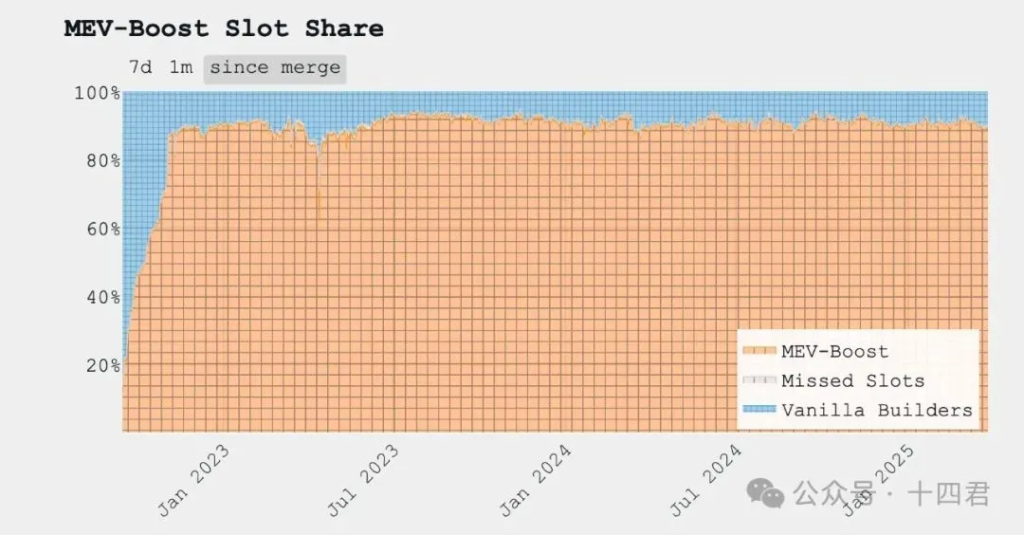
【Image source: https://mevboost.pics/ 】
The biggest difference between ETH and Solana is that there are multiple builders, and their different final returns affect the decision-making of validators, thus forming competition among builders.
Because of competition, searcher's profits are constantly shrinking. Because of competition, besides the algorithm, the only thing that affects the builder is the amount of data.
Searchers that cannot compete will exit the market, while builders that can obtain a large amount of information often have their own infrastructure and market reputation to form a stable total order flow, rather than relying on the propagation of Mempool between nodes.
This will result in ETH's MEV market being more market-oriented than a purely oligopolistic platform system like Solana, thus being able to give users some respite.
2. Solana’s Blockchain Mechanism
After understanding the ETH system, please clear your mind, because many things in Solana are different from Ethereum, even the traditional blocks are different.
It is these mechanisms that are the root cause of the rampant mev in the Solana system.
We can use a table to quickly compare these four core features:
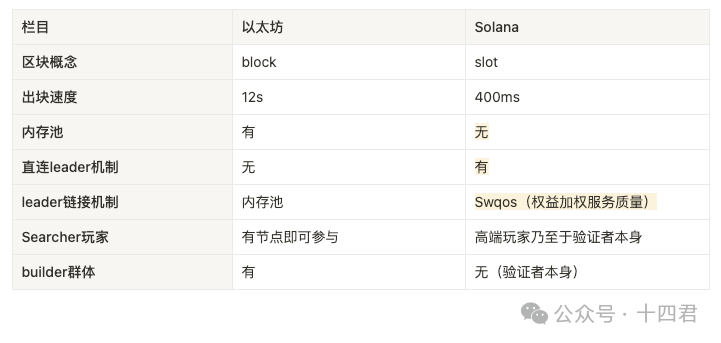
The key lies in the two features of no memory pool and direct connection to the leader. The former causes transaction delays and the latter causes validators to behave maliciously.
1) Solana does not actually have a memory pool
The 200ms delay of jito mentioned earlier, as well as its synchronous transmission to the blockengine, is actually a kind of monetized memory pool. So objectively speaking, if it does not have a memory pool mechanism (this is actually an optimization function of Solana to increase speed and protect privacy), how will it affect the block generation mechanism of transactions?
If you are an ordinary user, initiating a transaction and sending it to a certain node is equivalent to broadcasting.
Then under the default configuration, this node will immediately find the current leader and the next leader (a total of 2 validators) and submit your transaction.
As for the transaction order, where will it be? This is to distinguish between native Solana and jito-solana:
Native Solana: After the leader receives the transaction, in theory, it will follow the FIFO (first in, first out) principle to include the transaction that arrives first to the leader. Combined with the POH mechanism, it is equivalent to dividing a block into a large number of small ticks for synchronization.
Jito-Solana: Normal transactions to the leader have a queue for calculating the current gaslimit (called CU in the SVM system, computing resources), and its weight is lower than that of Bundle transactions, so normal transactions will be behind Bundle transactions. If it is the same transaction (that is, someone is attacking you), then Jito-Solana will prioritize packaging the transactions that attack you. Here he gives 80% to the Bundle, and only a mere 20% to the traditional ordinary transaction.
So, Solana does not have a memory pool, it just reduces public transfers, rather than completely eliminating transfers (which is also impossible). This feature makes Searcher on Solana exclusive to high-level players.
2) The leader of subsequent blocks is predictable
Validators will be randomly sampled from 1,300 validators every epoch (approximately 2-3 days). The VDF algorithm is used here, and there will be a weighted effect of staking weight.
For example, if the total sol pledged amount is 2 million, and you have pledged 200,000 sol, then you will have a 10% chance of being drawn in each random draw.
If you win the lottery, you will be responsible for the next 4 slots (the benchmark concept of blocks in Solana) of about 1.6 seconds. This speed is very fast, so any valid node can calculate who the subsequent validator is and try to connect with him to submit the user's transaction. Due to network delays, it is easy for the transaction to miss the current leader and be delivered to the next leader.
3) Leader’s connection strategy also has stake weighting
That is the SWQoS mechanism. The current leader's total p2p connection capacity is 2,500, of which 80% (2,000 connections) are reserved for SWQoS (that is, nodes that have made pledges).
The remaining 20% (500 connections) are allocated to transaction messages from non-staking nodes.
It sounds confusing, but it is actually a new mechanism to prevent spam and enhance Sybil resistance. The purpose is to allow the leader to prioritize transaction messages proxied by other staking validators.
3. Why is Solana vulnerable to attacks?
Even many ordinary users, in order to prevent their transactions from being squeezed, think that they can also pay high Priority Fees (transaction priority fees) so that miners can package their transactions first? In this way, they will not be squeezed? The truth is that it has a little effect, but not much, and in extreme cases it may even have a counter-effect.

[Image source: https://explorer.jito.wtf/feestats]
From the above figure, we can see that the Priority Fees given by users are actually similar and proportional probabilities, while tips are prone to fluctuations and competition, and tips are essentially a separate transaction. From an external perspective, it is actually unknown which transactions are in the Bundle.
Therefore, no matter how high your priority fee is, you can only be ranked in the last 20% of the validator's queue for block production in this slot. However, for the Searcher who can find your order at the beginning and launch a clamp attack on you, the average CU unit price of the Bundle with your high Priority Fees will be higher, and naturally it will be given priority in the validator's Bundle consumption queue, and the broadcast will be synchronized.
Similarly, at first glance, other scattered Solana mechanisms seem to be mechanisms that help users avoid being clamped. So why are the clamps on Solana the most rampant? The key points are:
1) It is difficult to prove that the leader is evil
There are AB2 leaders before and after the leader, and both can obtain transactions from all users, so the cost and ambiguity of leaderB doing evil are reduced.
You can imagine that, as the second leader, I see a profitable transaction, so I quickly construct a clamp attack and submit it to the blockengine for auction. Then, under the 80% Bundle priority mechanism, my attack will naturally take effect first, but the one packaged in it is leaderA.
So how do you determine that leaderB is an attacker?
Of course, you can say that leaderA finally packaged the attack transaction, so he is the attacker, but in the preset logic, 95% of the validators will do the same thing, so the chance of intervening with them becomes smaller.
Penalty A is actually unreasonable. After all, there are other links in the middle that may also lead to information leakage, as follows.
Transaction retry, long dwell time.
Each slot only takes 400ms, but have you ever experienced a transaction on Solana that inexplicably stayed for more than 23 seconds? You may have hastily thought that the node you are connected to is not powerful enough, but this is not the case. Because of the Swqos mechanism, if you connect to a normal node, it will calculate and find the leader to submit the transaction. However, when the network is congested, it only has a 500 connection pool for normal nodes. Once the connection fails and the submission fails, all transactions of the node will be retried every 2 seconds. The above parameters are all the underlying default parameters of the Solana node. Different nodes can have different settings (for example, change to 1s retry).
For ordinary users, how can the probability of encountering a retry be measured?
As of March 2025, Solana currently has approximately 1,300 validators and 4,000 RPC nodes. Once congestion occurs, 2700 nodes will compete for 500 connection pools within 1.6 seconds (4 slots). If the space for this leader is not filled, the next one will continue to look for the next one.
So under the illusion. How will they treat your transaction if it stays in the node for a long time? If your CU price is not high enough, and the leader is full and he has seen the transaction, what should he do?
Yes, they sell information. For nodes with large traffic, some searchers will buy them at a price of 10,000 US dollars per month and acquire the order flow.
2) Meme narrative and the scale of staking income
First, in the meme market stage, because Solana’s current mainstream narrative is the meme ecosystem, the on-chain pool is very shallow, which makes it easy for users to set loose slippage points in order to complete transactions, which also amplifies the searcher’s attack revenue (currently we have sampled a few and found that they can all achieve a revenue of $2, which is very high compared to eth’s revenue of almost $0.1).
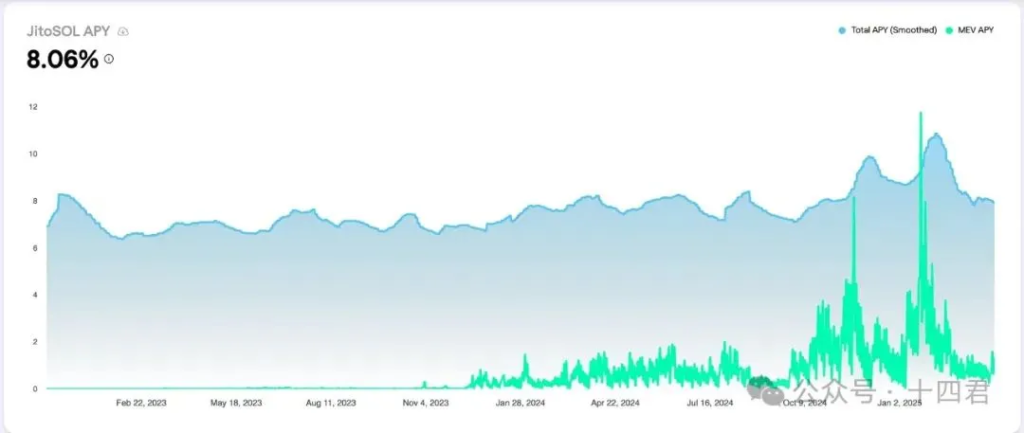
[Image source: https://www.jito.net work/zh/stats/]
The second is Solana’s validator staking income, which is about 8% annualized, a relatively stable value over the years.
The enhanced annualized return of mev is about 1.5%.
The combination of the two means that stakers can increase their staking yield by an additional 15–30% by additionally executing the jito-solana client. When the regional market explodes, even the yield of mev can exceed the staking income itself.
4. Why are Solana’s validators prone to defection?
The profits are simply too high, and the costs are also very high, forcing validators to continuously expand their sources and increase their revenue.
The voting cost for validators is about 300–350 SOL per year (estimated at $42,000 at a market price of $140) and $4,200 in hardware costs (not including the cost of the dynamic network).
Solana's huge node configuration burden requires node performance to be at least 24 cores, 256GB of memory, and 2*1.9TBNVME.
The most common customized Latitude model on the market, currently used by 14% of validators, costs $350 per month.
This ultimately resulted in only 458 of Solana’s 1,323 validators being profitable. This is why the "SIMD-0228 proposal" was voted down.
Judging from the results, this proposal will further reduce the incentive for block production, which will inevitably force smaller validators to withdraw. This may even lead to irreversible centralization of the platform. And as the benefits of mev go up and the benefits of essential work go down, what do you think will happen?
Let’s take a look at the strategies of competitors other than Jito.
3. Other competitors of MEV on Solana
1. Paladin: VIP preemption and transaction protection
Current market share: 5%. It will be launched at the end of 2023. As of March 2025, the official announcement is that 205 validator nodes have deployed Paladin and pledged 53M SOL. Using the Paladin client can increase node income by approximately 12.5%.
In fact, it is essentially based on a forked and modified version of the Jito-Solana client.
The core selling points of the launch are:
- P3 priority port: Let the leader of the block open this fast VIP channel and process it again according to the original FIFO rules.
- Identifying and troubleshooting clamp attacks: While this may initially seem detrimental to validator rewards, Paladin validators are compensated through a trust-based mechanism. Validators who avoid the “sandwich” can attract direct transactions, thereby building an ecosystem of trust and increasing returns.
- Paladin Bot: This is an open source high-frequency arbitrage robot that is executed directly on the local validator node and is only started when the node is elected as the Leader. When a Leader owns a Paladin Bot, it will quickly execute simple and risk-free MEV strategies (such as pairwise DEX spread arbitrage, centralized exchange and on-chain spread arbitrage, etc.), and directly include the profits into the validator's income.
As of December 3, 2024, the last bot has been officially deleted:
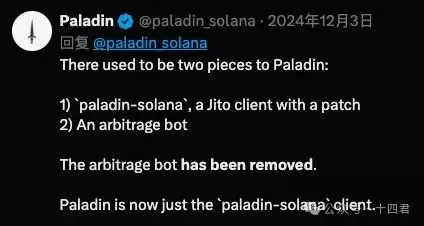
2. bloXroute: Network layer optimization + private channel protection
bloXroute Labs is an infrastructure company that provides the Blockchain Data Distribution Network (BDN), which has previously accelerated transaction broadcasts and reduced latency on chains such as Ethereum.
bloXroute does not directly participate in MEV allocation, but by providing a faster channel, it can help front-running transactions reach the Leader faster.
Unlike Jito/Paladin, bloXroute does not directly modify the Solana verification client or introduce a transaction auction mechanism, but instead provides a faster message channel for all nodes at the network layer.
The main idea is to relay Solana's block "shreds" (fragments) to all validators more quickly through a global acceleration node network, reducing the delay in data broadcast when the Leader generates blocks and forks caused by poor network conditions. So the services provided are:
- Solana BDN acceleration: According to official documents, bloXroute Solana BDN can reduce block fragment propagation latency by 30–50 milliseconds;
- The MEV-Protect RPC service is similar to Ethereum’s protected private transaction port, which indicates that bloXroute plans to allow users to send transactions privately to Leaders through its RPC to avoid being seen by third parties, thereby preventing front-running or preemption.
3. BlockRazor: Network layer optimization + private channel protection
BlockRazor is a new MEV infrastructure project established in 2024, and the team behind it is mainly from Asia. It positions itself as an "intention-centric network service provider" and plans to provide services such as MEV Protect RPC, high-performance network acceleration, MEV Builder, etc. on mainstream blockchains.
Scutum MEV Protect RPC: This is a private transaction gateway service launched by BlockRazor, similar to Flashbots Protect. Users can submit transaction bundles through Scutum RPC, and BlockRazor will ensure that these transactions are not released through the public mempool and are sent directly to block producers to avoid being front-run or sandwiched.
IV. Conclusion
1. How do you view the MEV competition landscape on Solana?
Just the day before yesterday, a new competitor entered the market.
Warlock Labs raised $8 million on March 27, 2025, aiming to reshape on-chain order flow.
However, he focuses on the Ethereum track, planning to provide some kind of proof for the order flow data and register it on the chain to ensure that they are accurate and responsible in processing users' transactions.
This is my point of view: in a truly good market, new competitors will continue to enter, but an oligopolistic market will lead to the blockage of challengers. So what kind of market does the platform expect to become?
Let's think a little deeper, what is really important in this mev infrastructure?
Paladin is built on jito-solana, which means that jito can actually upgrade a version and no longer support the so-called P3 channel, which is similar to the 3Q war of the year. In the end, whoever has a greater demand (obviously social) will win. The same thing happened when WeChat banned NetEase Cloud Music and other Moments from sharing. If there were no larger level of rule machines, then this set of exclusive competition strategies could be used indefinitely in any track. Moreover, Paladin’s current 5% market share is also due to the early use of built-in bots to increase validator profits. Although his open source bot is only non-aggressive (i.e., it does brick-moving and does not make sandwiches, etc., which obviously damage the interests of users), it was still pushed offline by market opinion.
Moreover, several other competitors, such as bloXroute and BlockRazor, all take the route of acceleration + privacy channel. The so-called privacy is limited to only one leader at the moment, so as to avoid the next one to do evil, and to directly attack both parties when facing evil.
The acceleration capability is indeed a solid technical strength today. It is also the focus of the next wallet/Dex market war.
Objectively speaking, Solana's original client code still has some historical debts, so someone once came out and modified the client to make it have lower configuration and faster synchronization. In addition, combined with the Swqos mechanism, being a validator can actually improve the connection stability and success rate.
In addition, Jito’s blockengine system is actually a multi-center system, but no matter how multi-center it is (not completely decentralized), there will still be single points of failure. Since it is also the core link of the upstream, once it crashes, it is roughly equivalent to Solana crashing. Therefore, in order to achieve multi-node disaster recovery and speed up, the system still has to go through a wave of stress testing challenges. This is why there are more bugs in the Binance wallet, and many historical technologies have not yet been caught up.
But the issue of technical strength will eventually be resolved.
Any company can long node global optimization and finally establish the shortest communication channel in whichever continent the leader is in, so that their transactions can reach the leader quickly. They can also establish a multicast strategy to divert the needs of different users. The future competition results will inevitably be the result of refined operations.
But what cannot be solved is the problem of market competition crowding out.
If jito-solana takes advantage of its oligopoly and modifies the Bundle priority policy from 80% to 90% or even 95%, then ordinary users will have no choice but to raise the Priority Fees infinitely to compete for the remaining 5% CU space.
But here, when the total CU is underutilized, it will eventually affect the total value of the validator's income (and because a large number of transactions are piled up in the unprocessed queue, the validator's motivation to do evil is stronger), so Jito will not start such a competition mode unless it is absolutely necessary.
So why is ETH's market competition more open? And Solana’s competition is more exclusive?
The author believes that the root cause is the lack of the Builder bidding role.
ETH can have multiple builders produce multiple final block sequences, and the validator only verifies and selects which one. However, Solana only has multiple blockengines (all of which are owned by the same company), and the transaction queue it gives to the validator is actually a single Bundle (5 transactions), which eliminates the need for multiple Builder competition.
Objectively speaking, there is no absolute fairness in the history of ETH. This competition will significantly increase the income of validators and reduce the income of searchers. When the income of searchers decreases, the number of attacks will also decrease, and eventually a balance will be reached.
In the future when technology and market are balanced, what is real competitiveness?
I believe that this point will be resolved when the technological gap is bridged with talent competition and investment, and when the market's centralization and decentralization ultimately affect the overall SOL ecosystem. Solana has now started discussions on multiple builders, and has even gone a step further to discuss solutions for multiple leaders to further randomly generate blocks.
Although more leaders also mean that more people will get your order, since the person who finally produces the block is a random one among multiple people queuing at the same time, it also realizes the competition among multiple builders in disguise, and the market impact will be the same as before.
Then the real competitiveness will be transferred to the data island of order flow.
For example, Jupiter has occupied more than 80% of the DEX market share, so its order flow is the most popular. It depends on how it balances providing the best price or randomly picking some "lucky geese" to make a profit, even if it loses some brand reputation.
I think the reason why they don't build their own mev infrastructure is probably that in the face of the developing market stage, no one can say that they are as strong as the traditional big companies, so focusing on profits at this time will give competitors the opportunity to overtake. Moreover, mev is always a game theory problem. Once it reaches a monopoly position, the support of the validators on whom the monopoly relies will push the facilities to make profits.
Any dragon slayer seems to have the unstoppable potential to become a dragon, and become a combination of dragon and warrior. Of course, you may say that Jito was originally an infrastructure aimed at MEV, so how could it be a dragon slayer?
2. What are Jito’s merits and demerits for Solana?
A lot of what I said before was Jito’s fault, so did Jito have any merits?
Objectively speaking, jito has done some good.
When I started looking at Solana 3 years ago, I sneered at it (ok, I admit I was too loud at that time), but the root of such analysis was that its failure rate was too high.
Why is there such a high failure rate?
On the one hand, there were too many bugs in the early program code, but later it was discovered that paying money could solve most of the problems (machine configurations continued to improve). On the other hand, there is the FiFo strategy. When there is a highly profitable transaction on the chain, even if it is just a backrun attack, whoever follows the closest will make a higher profit.
Obviously, each Searcher will build a set of facilities to transmit transactions to the leader as quickly as possible, so early leaders are always vulnerable to flood attacks.
With the emergence of blockengine, Jito has further created a bidding process. If you see profit, you can bid first, and the traffic will be diverted here.
The auction here also has a function to intercept failed transactions. Because if your transaction conflicts with someone else's, and the other person's price is higher, then since the two Searchers are sandwiched between the transactions of the same person, there must be a storage conflict. So if you cannot win the bid, the blockengine will directly reject you, and then you raise the price again and continue the auction (it may also reject you randomly, making you mistakenly believe that you must bid further. OK, how friendly it is to kill the familiar with big data).
Of course, you may ask, why do we still see so many failed transactions on Solana?
Of course, because blockengine is multi-center, the block generation speed of 400ms between different centers makes it impossible to synchronize data quickly, thereby eliminating the auction errors caused by different blockengines.
Therefore, the author believes that Jito also has a contribution, after all, he has greatly reduced the crash rate of Solana.
In addition to crashes, his bundled transactions also provide the market with multiple application scenarios.
For a market to be prosperous, it actually needs to serve market makers well. Solana's most explosive market is the Meme market, which is inseparable from the group that opens the market. They need to "covertly" start collecting low-priced chips at the same time as the launch. This is a highly sniped scenario. If the operator of the plate cannot collect enough profitable low-priced chips, then he may simply give up pulling the market and reopen it directly.
In fact, it was disadvantageous to both parties. After all, his initial move wasted.
There are also other transactions that need to be accelerated, such as various dex. Now they trust that jito-solana will not sell data as blatantly as before. Therefore, for high-value transactions, users will be asked to give an additional tip fee and take the fast route of blockengine, directly occupying 80% of the CU processing queue, thereby increasing transaction speed and avoiding being squeezed.
Increase the returns of Solana stakers and improve overall decentralization
The previous data has been analyzed. Solana's own staking income is about 8% annualized. Through Jito's mevtip income, it can reach about 10%, which is a good space.
And only 458 of Solana’s 1,323 validators are profitable. Even if jito does not charge any fees, it is completely unprofitable (otherwise who would do it). In fact, the others are either directly doing evil, indirectly doing evil, or their motives are not to make money (for example, they only do it to speed up Swqos). Essentially, the above statistics are based on staking returns rather than fully incorporating mev returns.
Therefore, it is because of the existence of jito that the remaining 800 validators can make profits and that Solana is less centralized today.
Therefore, on the whole, Jito-solana still has some merits. At least for now, it has not completely adopted an exclusive competition strategy. At this time, there is still an opportunity for a third party to enter the market.
3. How will the MEV landscape develop in the future?
I have mentioned several key points before. I think that although it seems that there is one dominant player and many strong companies now, it is actually a time when opportunities are lurking.
First, because the profit of MEV on Solana is generally higher (about 2U, better than ETH's about 0.1U), the meme trend will continue to be traded forever with different narrative scenarios, so new Searchers will enter. Although the higher order flow acquisition cost on Solana blocks some small players, the competition among large players will also increase investment along with profits.
Second, there is a lot of opposition on Solana that is fighting against the MEV infrastructure. This forced Jito to announce the closure of the data selling channel and also forced Paladin to delete the built-in bot function. Among proposals such as simd-228, there is also the simd-96 proposal that has been passed.
Originally, half of the total of base fee + Priority Fees received by the validator will be destroyed, but now only half of the base fee will be destroyed. This indirectly increases the benefits of validators for packaging transactions of normal users, thereby increasing their motivation to fight against Jito's reduction of the weight of ordinary transactions. There are constantly new proposals participating in Solana’s macro decision-making game.
Third, the overall profit margin of mev is large enough. For example, last year, Jito Labs’ fee income in October was US$78.92 million, twice the record of US$39.45 million set in May, and higher than old DeFi protocols such as Lido and Uniswap. Even if Jito itself wants to share dividends with the validator, the overall spread is the lower limit of the user's loss scale. The greater the loss, the greater the motivation, and users' expectations for reliable services can also be quantified. That is the opportunity for BlockRazor and bloXroute.
Moreover, I am looking forward to some more advanced explorations:
- Starting from private transactions: there are threshold encryption, delayed encryption and SGX encryption, which basically require decryption conditions based on encrypted transaction information, or time locks, multi-signatures or trusted hardware models.
- Starting from fair trading: there are fair sorting FSS and order flow auction MEV Auction, as well as MEV-Share, Mev-Blocker, etc. The difference lies from no profit at all to sharing profits to weighing profits, that is, it is up to the user to decide what cost to use to obtain the relative fairness of the transaction.
- Improve PBS at the protocol level. Currently, PBS is actually a proposal of the Ethereum Foundation, but it has been separated with the help of MEV-boost. In the future, such core mechanism will be transformed into the protocol mechanism of Ethereum itself.
Most of these have already been proposed on Ethereum itself, but the compatibility differences have prevented them from coming to the attention of users. However, these are also areas where Solana itself can learn from.
5. Final Thoughts
The end of competition is often not surpassed by the efforts of the same track. What will kill Jito will not be the next Jito (he also has his merits and faults), but a completely new form of application.
The author summarized the profit sources of UniswapX's operating process and wanted to fully depict the specific rate of return of MEV. After all, this is the source of what it fights against and distributes dividends to users (essentially losing the immediacy of transactions but in exchange for a better exchange price).
Similarly, order book exchanges (and even decentralized exchanges) are also good tools to fight MEV. Imagine that when computing power is further improved in the future and daily transactions are further expanded, the AMM mechanism and the corresponding maximum attack scenario of MEV attacks will disappear. But the other challenges facing the order book are no less significant than the MEV problems.
From the recent twists and turns of Hyperliquid, we can see that, putting aside the concerns about centralization, as web3 as a whole moves towards compliance regulation, the players at the table have already put on suits and stepped into the international arena.
At this time, compliance is an all-round sword. After all, at this time, it stands on the side of the user.






